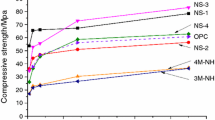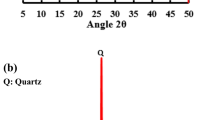Abstract
The present study investigates the correlation between the degree of reaction (DoR) and hydration (DoH) of alkali-activated slag cements, prepared using a sodium silicate activator. The DoR of samples was measured by employing multiple techniques including 29Si magic-angle-spinning nuclear magnetic resonance spectroscopy, scanning electron microscopy image analysis, and selective dissolution, while the DoH was quantified by bound water measurement of samples dried via various drying methods. Due to experimental errors it is recommended that the DoR is described using regression as a function of time, rather than directly using experimentally-obtained values. The DoH values obtained from the measurement of bound water content showed a linear relationship with the DoR values measured by selective dissolution within 20% error margin. From this, it is expected that DoR can be inferred from DoH values obtained by the drying method, which is much easier than selective dissolution.










Similar content being viewed by others
References
Provis JL (2017) Alkali-activated materials. Cem Concr Res 114:40–48
Provis JL, Palomo A, Shi C (2015) Advances in understanding alkali-activated materials. Cem Concr Res 78:110–125
Luukkonen T, Abdollahnejad Z, Yliniemi J, Kinnunen P, Illikainen M (2018) Comparison of alkali and silica sources in one-part alkali-activated blast furnace slag mortar. J Clean Prod 187:171–179
Abdollahnejad Z, Mastali M, Luukkonen T, Kinnunen P, Illikainen M (2018) Fiber-reinforced one-part alkali-activated slag/ceramic binders. Ceram Int 44(8):8963–8976
Luukkonen T, Abdollahnejad Z, Yliniemi J, Kinnunen P, Illikainen M (2018) One-part alkali-activated materials: A review. Cem Concr Res 103:21–34
Pacheco-Torgal F, Abdollahnejad Z, Camões A, Jamshidi M, Ding Y (2012) Durability of alkali-activated binders: a clear advantage over Portland cement or an unproven issue? Constr Build Mater 30:400–405
Tazawa E-i, Miyazawa S, Kasai T (1995) Chemical shrinkage and autogenous shrinkage of hydrating cement paste. Cem Concr Res 25(2):288–292
Odler I, Rößler M (1985) Investigations on the relationship between porosity, structure and strength of hydrated Portland cement pastes. II. Effect of pore structure and of degree of hydration. Cem Concr Res 15(3):401–410
De Schutter G, Taerwe L (1996) Degree of hydration-based description of mechanical properties of early age concrete. Mater Struct 29(6):335
Yu P, Kirkpatrick R (1999) Thermal dehydration of tobermorite and jennite. Concr Sci Eng 1:185–191
Haha MB, Lothenbach B, Le Saout G, Winnefeld F (2011) Influence of slag chemistry on the hydration of alkali-activated blast-furnace slag—Part I: effect of MgO. Cem Concr Res 41(9):955–963
Zuo Y, Nedeljković M, Ye G (2018) Coupled thermodynamic modelling and experimental study of sodium hydroxide activated slag. Constr Build Mater 188:262–279
Gruskovnjak A, Lothenbach B, Holzer L, Figi R, Winnefeld F (2006) Hydration of alkali-activated slag: comparison with ordinary Portland cement. Adv Cem Res 18(3):119–128
Snellings R, Salze A, Scrivener K (2014) Use of X-ray diffraction to quantify amorphous supplementary cementitious materials in anhydrous and hydrated blended cements. Cem Concr Res 64:89–98
Durdziński PT, Haha MB, Bernal SA, De Belie N, Gruyaert E, Lothenbach B, Méndez EM, Provis JL, Schöler A, Stabler C (2017) Outcomes of the RILEM round robin on degree of reaction of slag and fly ash in blended cements. Mater Struct 50(2):135
Myers RJ, Lothenbach B, Bernal SA, Provis JL (2015) Thermodynamic modelling of alkali-activated slag cements. Appl Geochem 61:233–247
Wang S-D, Scrivener KL (2003) 29 Si and 27 Al NMR study of alkali-activated slag. Cem Concr Res 33(5):769–774
Wang S-D, Scrivener KL (1995) Hydration products of alkali activated slag cement. Cem Concr Res 25(3):561–571
Le Saoût G, Ben Haha M, Winnefeld F, Lothenbach B (2011) Hydration Degree of Alkali-Activated Slags: A 29Si NMR Study. J Am Ceram Soc 94(12):4541–4547
Kocaba V, Gallucci E, Scrivener KL (2012) Methods for determination of degree of reaction of slag in blended cement pastes. Cem Concr Res 42(3):511–525
Haha MB, Le Saout G, Winnefeld F, Lothenbach B (2011) Influence of activator type on hydration kinetics, hydrate assemblage and microstructural development of alkali activated blast-furnace slags. Cem Concr Res 41(3):301–310
Wang S-D, Scrivener KL (2003) 29Si and 27Al NMR study of alkali-activated slag. Cem Concr Res 33(5):769–774
Abate SY, Song K-I, Song J-K, Lee BY, Kim H-K (2018) Internal curing effect of raw and carbonated recycled aggregate on the properties of high-strength slag-cement mortar. Constr Build Mater 165:64–71
Lee NK, Abate SY, Kim H-K (2018) Use of recycled aggregates as internal curing agent for alkali-activated slag system. Constr Build Mater 159:286–296
Korpa A, Trettin R (2006) The influence of different drying methods on cement paste microstructures as reflected by gas adsorption: comparison between freeze-drying (F-drying), D-drying, P-drying and oven-drying methods. Cem Concr Res 36(4):634–649
Kim H, Lee H-K (2018) Hydration kinetics of high-strength concrete with untreated coal bottom ash for internal curing. Cem Concr Compos 91:67–75
Scrivener K, Snellings R, Lothenbach B (2016) A practical guide to microstructural analysis of cementitious materials. CRC Press
Luke K, Glasser FP (1987) Selective dissolution of hydrated blast furnace slag cements. Cem Concr Res 17(2):273–282
Escalante J, Gomez L, Johal K, Mendoza G, Mancha H, Mendez J (2001) Reactivity of blast-furnace slag in Portland cement blends hydrated under different conditions. Cem Concr Res 31(10):1403–1409
Prentice DP, Bernal SA, Bankhead M, Hayes M, Provis JL (2018) Phase evolution of slag-rich cementitious grouts for immobilisation of nuclear wastes. Adv Cem Res, pp 1–16
Myers RJ, Bernal SA, Gehman JD, Deventer JS, Provis JL (2015) The role of Al in cross-linking of alkali-activated slag cements. J Am Ceram Soc 98(3):996–1004
Park S, Jang J, Lee H (2018) Unlocking the role of MgO in the carbonation of alkali-activated slag cement. Inorganic Chemistry Frontiers
Nemati KM, Stroeven P (2001) Stereological analysis of micromechanical behavior of concrete. Mater Struct 34(8):486–494
Scrivener KL, Lothenbach B, De Belie N, Gruyaert E, Skibsted J, Snellings R, Vollpracht A (2015) TC 238-SCM: hydration and microstructure of concrete with SCMs. Mater Struct 48(4):835–862
Park S, Abate SY, Kim H-K (2020) Hydration kinetics modeling of sodium silicate-activated slag: a comparative study. Constr Build Mater 242:118144
Poppe A-M, De Schutter G (2005) Cement hydration in the presence of high filler contents. Cem Concr Res 35(12):2290–2299
Acknowledgments
This research was supported by grants from the National Research Foundation of Korea [2019R1A4A1028116 and 2020R1A2C4002107] and Chosun University. The opinions expressed in this paper are those of the authors and do not necessarily reflect the views of the sponsors.
Author information
Authors and Affiliations
Corresponding author
Ethics declarations
Conflict of interest
The authors declare that they have no conflict of interest.
Additional information
Publisher's Note
Springer Nature remains neutral with regard to jurisdictional claims in published maps and institutional affiliations.
Rights and permissions
About this article
Cite this article
Park, S., Abate, S.Y., Lee, H.K. et al. On the quantification of degrees of reaction and hydration of sodium silicate-activated slag cements. Mater Struct 53, 65 (2020). https://doi.org/10.1617/s11527-020-01505-9
Received:
Accepted:
Published:
DOI: https://doi.org/10.1617/s11527-020-01505-9




